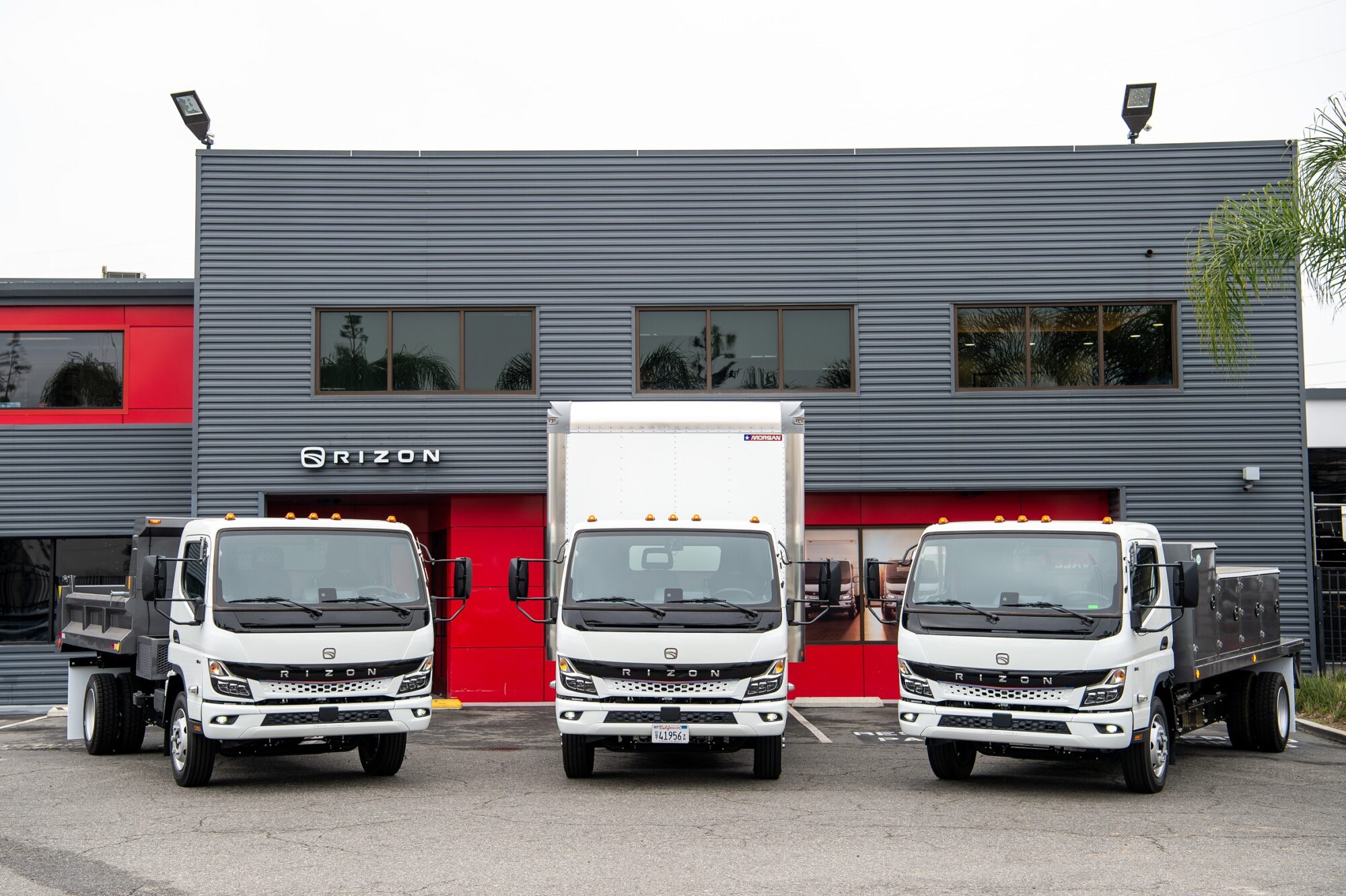EV total cost of ownership (TCO) is a complex topic for businesses as they increasingly look at electric trucks as a viable alternative to traditional diesel-powered vehicles. The decision to switch is driven not just by environmental concerns, but by a compelling financial case. Electrifying fleet vehicles, if done properly, can result in a reduced TCO.
Below, are five key ways EV total cost of ownership can benefit businesses.
1. Choose the Right Vehicles to Electrify

The first step for businesses looking to reduce the TCO with electric vehicles is to assess their fleet usage. Simply replacing an internal combustion engine (ICE) vehicle with an electric vehicle doesn’t automatically reduce the TCO.
Check out RIZON’s fleet electrification guide for ideas on how to begin the process.
Reducing an EV’s TCO begins by replacing the right ICE vehicle with an electric one. This requires evaluating the daily range requirements while assuring the EV drives far enough yearly to generate enough cost savings on fuel, maintenance, and general operations.
For instance, vehicles operating in urban environments that spend a lot of time idling in traffic, have more predictable and shorter routes and can charge overnight at a depot are ripe for electrification.
Aggregate data collected from the California Air Resources Board show that a majority of commercial vehicles in urban routes drive fewer than 100 miles per day. These types of fleet vehicles should be considered first for electrification.
2. Reduced Fuel Costs

According to the Pew Research Center, 70 percent of potential EV buyers list “saving money on gas” as one of their top reasons for considering going electric.
The good news is electricity is generally cheaper per mile than gasoline or diesel.
How much you can save by recharging a battery as opposed to a fill-up will vary depending on the local rates and the charging type. For example, DC fast charging can be up to three to four times more expensive than AC charging. Despite this, a driver of an EV can still expect to save money.
While gasoline and diesel prices are clearly displayed, most people don’t know the cost of electricity in their area making it difficult to determine savings. Luckily, Energy Innovation maintains an updated U.S. map listing the expected savings in every state for charging different types of electric vehicles.
A Case Study
The Washington Post even tested the cost of charging by conducting a road trip from San Francisco to Disneyland in Southern California with an electric pickup. They found that even by using more expensive DC fast charging, charging was still cheaper than a fill-up.
Had the driver used Level 2 charging at hotels or restaurants, the savings would have been greater. However, the Post concluded that it is cheaper for everyday Americans to charge an EV than refuel an ICE vehicle. This was more acutely measured in states like Washington, where fuel prices are higher, but electricity rates are lower.
The Bottom Line
As of August 2024, the average electricity price in the U.S. is 0.16 USD per kilowatt-hour and 0.192 CAD in Canada. While European markets typically experience higher electricity prices, battery electric trucks are predicted to be the cheapest fuel technology for commercial vehicles across all classes, from long haul to light-duty trucks.
3. Lower Service, Maintenance and Repair (SMR) Costs Results in Lower EV Total Cost of Ownership

Electric trucks can also be less expensive to maintain than their diesel counterparts. The simplicity of electric motors, which have fewer moving parts than internal combustion engines, results in fewer components that can fail or wear out over time.
Not only that, EVs enjoy two important advantages in reduced SMR costs.
Durable Brakes
A key reason is their reduced need for brake servicing. Regenerative braking in electric vehicles captures kinetic energy, converting it into electrical power that helps recharge the battery. This system slows the vehicle without relying heavily on traditional brakes, which means brake pads and rotors last much longer. In contrast, brake pads and discs are among the most commonly serviced components in ICE vehicles.
No Oil Changes
Another advantage of electric vehicles is that they don’t require engine oil. EVs have fewer mechanical parts, which reduces the chances of breakdowns and reduces the need for routine maintenance like engine oil changes or injector service. ICE vehicles, on the other hand, commonly require servicing of components such as oil filters, air filters, and other mechanical parts.
Lower SMR Costs Reported from Service Providers
While electric fleet vehicles are relatively new and have a more limited data set, there are strong indicators that EV SMR will continue to cost less than ICE vehicles, according to Fleet Assist, which maintains more than 5,200 franchised and independent garages in the U.K.
Fleet Assist found the average cost of battery electric vehicle SMR was 40% lower than all other vehicle types including ICE and hybrid in 2022 compared with 2021.
The caveat in the report is that the BEV vehicles used for comparison were three-and-a-half years newer than most of the ICE vehicles.
Another company, Rivus, reported that SMR costs for electric light-duty vehicles were 20% lower than their ICE equivalents, with service costs being 65% lower.
Some publications are even so bold as to claim EVs are nearly halving fleet SMR costs.
More Analysis is Needed
It should be noted that BEVs have a relatively short period to draw data from and not all comparisons are conclusive. SMR costs are likely to vary from model to model. However, the current data looks promising.
4. Government Incentives and Tax Credits

Considering TCO means reflecting on the overall cost. While the purchase price of electric commercial trucks is higher, depending on the market, incentives are available.
In addition to operational savings, electric trucks can benefit from various government incentives that can significantly reduce their upfront costs. In the U.S., businesses can receive federal tax credits of up to $40,000 per electric vehicle (14,000 pounds or more), depending on the model and battery capacity.
Local incentives are available in some areas, including California’s Hybrid and Zero-emission Truck and Bus Voucher Incentive Program (HVIP), in which RIZON trucks are eligible for $60,000 in funding per truck.
5. EV Fleet Vehicles Will Only Get Cheaper Further Reducing EV Total Cost of Ownership

The transition to electric trucks offers significant financial benefits for fleet owners and businesses. And the good news is this will only improve in the future with the advancement of battery technology and charging infrastructure.
The U.S. Department of Energy (DOE) released a comprehensive study showing that “by 2030, nearly half of all medium- and heavy-duty trucks will be cheaper to buy, operate, and maintain as zero emissions vehicles than traditional diesel-powered combustion engine vehicles.”
This is due to continued improvements in zero-emission technology, which will make commercial BEV vehicles cheaper and more widely available in the coming decade.
This assessment isn’t limited to the DOE. The International Council on Clean Transportation also determined that battery electric trucks will be the least-costly path towards decarbonization before 2030, with electric medium-duty trucks being 23% cheaper to fuel.
How Much Will You Actually Save With an EV?
While it is difficult to predict just how much you can save by purchasing an electric fleet vehicle SaaS provider, GeoTab tried by analyzing real-world data from North America and Europe from more than 750,000 ICE vehicles.
They predict that if EV-suitable vehicles are implemented, meaning appropriate for transitioning to electric based on assessment criteria, the average per lifetime savings gained per vehicle for Canada would be CAD 24,221 CAD, and USD 14,960 in the U.S.
Conclusion
The transition to electric trucks offers significant financial benefits for fleet owners and businesses. The earlier a business starts preparing for the transition, the more it will benefit from reduced TCO.
Lower fuel and maintenance costs, combined with government incentives, extended vehicle lifespans, and stable operating expenses, all contribute to a lower total cost of ownership. As the commercial vehicle industry continues to evolve, electric trucks represent a smart investment for businesses looking to reduce costs and enhance operational efficiency.

